Promoting the Successful Participation of People with Disabilities in STEM (2014)
February 25-28, 2014
University of Washington
Seattle, Washington
The Alliance for Students with Disabilities in Science, Technology, Engineering, and Mathematics (AccessSTEM) coordinates multiple activities to increase the participation of students with disabilities in science, technology, engineering, and mathematics (STEM) postsecondary education and career fields. AccessSTEM is led by the DO-IT (Disabilities, Opportunities, Internetworking, and Technology) Center at the University of Washington (UW) and is supported by the Research and Disabilities Education (RDE) program of the National Science Foundation (NSF) (Grant #HRD-0227995 and HRD-0833504).
This publication shares the proceedings of Promoting the Successful Participation of People with Disabilities in STEM, an AccessSTEM-sponsored capacity building institute (CBI) that was held at UW in Seattle on February 25–28, 2014. The content may be useful for people who:
- participated in the CBI
- want to create a more inclusive environment for students with disabilities in STEM programs and careers
- want guidance for conducting a CBI at their institution, in their region, or within a national or international forum
- want to increase their understanding of issues surrounding inclusion and STEM
- are motivated to engage in an electronic community to discuss these issues
- would like to access resources to help them make their campus courses, services, and activities more welcoming and accessible to a diverse group of students
- have promising practices to share with others through future engagement
About AccessSTEM
AccessSTEM helps:
- K-12 teachers, postsecondary educators, and employers make classroom and employment opportunities in science, technology, engineering, and mathematics (STEM) accessible to individuals with disabilities, and provides a place to share promising practices
- students with disabilities succeed in STEM courses and reach critical junctures on paths toward college studies and careers in STEM fields
AccessSTEM builds on established collaborations and brings together practices that have been successful individually, to create a unique and comprehensive set of interventions. AccessSTEM:
- implements changes within postsecondary institutions to make STEM programs more welcoming and accessible to students with disabilities, including veterans
- creates and expands engagement of stakeholders (precollege STEM educators, disability services, veteran associations, projects that broaden participation in STEM, and industry and career services) in fostering STEM education and careers that are welcoming and accessible to people with disabilities
- creates synergistic and lasting relationships among stakeholders to foster systemic changes regarding the inclusiveness of STEM education and careers that are not likely to be made in isolation
- implements evidence-based practices to increase the numbers of individuals with disabilities moving through critical junctures to STEM careers
- supports an online resource center that shares research and promising practices worldwide
The lead agency for AccessSTEM is UW’s award-winning DO-IT Center, which has conducted successful NSF projects continuously since 1992. AccessSTEM works with a leadership team of partners that represent stakeholders including postsecondary institutions, precollege STEM educators, disability services, veteran associations, projects that broaden participation in STEM, and industry and career services.
About the CBI
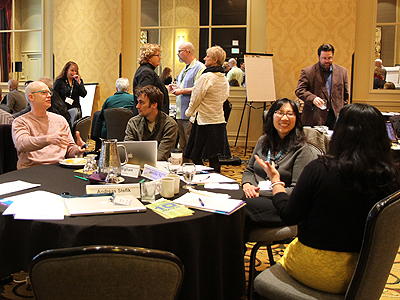
The CBI for Promoting the Successful Participation of People with Disabilities in STEM took place in Seattle, Washington on February 25-28, 2014. The CBI provided a forum for sharing interventions that promote the full inclusion of people with disabilities in STEM postsecondary programs and careers. Attendees included postsecondary faculty, disability service providers, individuals who have led or participated in projects funded by the NSF’s Research in Disabilities in Education (RDE) program, and representatives from key professional organizations. In total, over fifty participants from around the country were in attendance.
The CBI provided a forum to share expertise, practices, suggestions for future collaborations, and funding ideas. Speakers and panelists were also CBI participants. Many had disabilities and/or were practitioners with direct experience in serving students with disabilities. Broad issues discussed include
- faculty and staff engagement in universal design;
- transition supports;
- technology access; and
- the support of STEM students with disabilities through academic coaching, mentoring, internships, and other interventions.
In small working groups, participants responded to the following questions:
- What are examples of interventions that can promote participation and success of students with sensory impairments studying STEM?
- What are specific academic coaching, mentoring, and other interventions that can be employed to support students with disabilities?
- How can postsecondary faculty and other stakeholders promote the STEM success of students with disabilities using universal design and other strategies?
- How can K-12 educators and other stakeholders employ universal design or other interventions to facilitate interest and success in STEM education for students with disabilities?
- What kind of supports for K-12 to college, two-year to four-year, and military to civilian transitions might maximize the success of students with disabilities in STEM?
- What technology or science equipment strategies have the potential to promote the success of students with disabilities?
- Where do we go from here? How can we continue to work together after the CBI?
In this CBI
- all participants contributed to its success;
- experts in all topic areas were in the audience; and
- new concepts evolved from discussion of presented material.
Project staff supported online and telephone communication pre- and post-CBI so that participants could engage in the planning of the event and follow-up activities. The CBI was comprised of individual presentations and group discussions. CBI participants shared perspectives, expertise, practices, and suggestions for future collaborations as well as funding opportunities; and heard about the experiences of STEM students with disabilities in a panel presentation. Featured speakers included AccessSTEM Principle Investigator (PI) and Director Sheryl Burgstahler and Mark Leddy, NSF Program Officer.
The agenda for the CBI and summaries of the presentations are provided on the following pages.
CBI Agenda
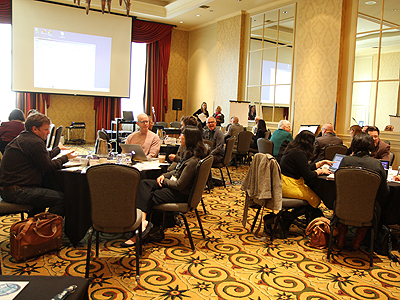
Tuesday, February 25
7:00 – 9:00 p.m.
Evening Social and Time to Get Acquainted
Wednesday, February 26
8:00 a.m.
Networking and Buffet Breakfast
9:00 a.m.
Welcome and Introductions
Sheryl Burgstahler, AccessSTEM PI and CBI Facilitator
10:00 a.m.
Case Study: Engaging Individuals with Disabilities in an Engineering Research Center
Scott Bellman and Eric Chudler
10:15 a.m.
Break
10:30 a.m.
Sensory Impairments and STEM Students
- Captioning Video Presentations
Doug Hayman and Terrill Thompson - Collaborative Real-Time Captioning
Jeffrey Bigham - Deaf STEM Community Alliance and Mainstream Real-Time Captioning
Lisa Elliot - On the Participation of Blind and Visually Impaired Individuals in STEM and Computer Science
Andreas Stefik
11:00 a.m.
Working Group Discussions
11:40 a.m.
Working Lunch and Brainstorming
12:30 p.m.
Working Group Reports
1:00 p.m.
Report from National Science Foundation
Mark Leddy, Program Officer
1:30 p.m.
Supporting STEM Students with Disabilities through Academic Coaching, Mentoring, and Other Interventions
- Academic Coaching Model
Ronda Jenson - Mentorship Support Model for Students with Learning Disabilities in STEM
Consuelo Kreider, Tony Delisle, and Jim Gorske - Mentoring in STEM
Robert Stodden - FabFems Project: a Tool of the National Girls Collaborative
Nimisha Ghosh Roy
2:30 p.m.
Break and Working Group Discussions
3:15 p.m.
Working Group Reports
3:30 p.m.
Faculty/Staff Engagement and Universal Design
- Creating a Faculty Special Interest Group on Disabilities andAccessibility
Jonathan Lazar - Advising Model
Christopher Anderson - How to Engage with the Association on Higher Education and Disability (AHEAD) and AHEAD Resources
Stephan Smith - Creating and Distribution of Opportunities! Newsletters
Bree Callahan and Scott Bellman
4:30 p.m.
Working Group Discussions and Reports
5:15 p.m.
Day 1 Closing Remarks, Preview of Tomorrow’s Topics, Evaluation, and Feedback
5:30 p.m.
Break
6:30 – 8:30 p.m.
Working Dinner
Thursday, February 27
8:15 a.m.
Networking Breakfast
9:00 a.m.
Overview of Agenda
9:05 a.m.
Introduction of Guests and Overview of How DO-IT Leveraged AccessSTEM’s NSF Funding to Take Off With Boeing Funding
Debra Zawada
9:20 a.m.
Interventions with a K-12 Focus
- The National Center for Women & Information Technology (NCWIT) Resources on Inclusion
Terry Morreale - National Science Teachers Association (NSTA) Resources
William Badders - Fifteen Tips for Implementing Universal Design
Al Souma - Preparation for Postsecondary STEM Studies in High School Math and Science Among Youth with Autism
Jennifer Yu and Jose Blackorby - Attracting Girls, Special Needs, Minority, and Underserved Students to STEM Majors and Careers
Daniela Marghitu
10:20 a.m.
Break and Working Group Discussions
11:00 a.m.
Working Group Reports
11:15 a.m.
Group Photo, Working Lunch, and Panel: Personal Experiences in Pursuing STEM Fields
1:00 p.m.
Transition Supports
- Ability Advising/Student Learning Communities
John Gallagher - Veteran Education Transition Supports in College
Yovhane Metcalfe - Autism Spectrum Navigators Program
Susan Gjolmesli and Sara Gardner
1:45 p.m.
Break and Working Group Discussions
2:30 p.m.
Working Group Reports
2:45 p.m.
Technology Access
- Access Technology Center
Dan Comden - Accessible Science Equipment
Kayla Brown - Technology Adoption and Students with Learning Disabilities
Katherine Deibel
3:30 p.m.
Break and Working Group Discussions
4:15 p.m.
Working Group Reports
4:30 p.m.
Day 2 Closing Remarks, Preview of Tomorrow’s Topics, Evaluation, and Feedback
5:00 p.m.
Dinner
Friday, February 28
8:15 a.m.
Networking Breakfast
9:00 a.m.
Overview of Agenda and Debriefing on Evaluation Ideas
9:30 a.m.
Final Discussion and Evaluation
12:00 p.m. – 1:00 p.m.
Networking Lunch
Presentation Summaries
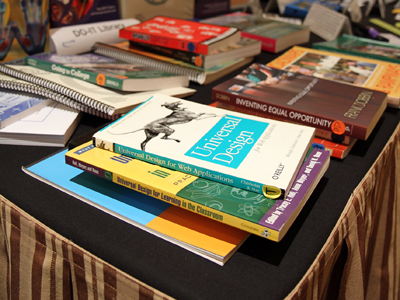
Case Study: Engaging Individuals with Disabilities in an Engineering Research Center
Presenters:
Scott Bellman, Program Manager, DO-IT, UW
Eric Chudler, Executive Director, Center for Neurotechnology (CNT), University of Washington
DO-IT staff work within an NSF-funded Engineering Research Center to engage people with disabilities in research, product development, outreach programs, administration, and other activities. Students with disabilities are featured in CNT promotional materials and three students with disabilities have completed internships in CNT labs.
Sensory Impairments and STEM Students
Captioning Video Presentations
Presenters:
Doug Hayman, Program Coordinator, DO-IT, UW
Terrill Thompson, Technology Accessibility Specialist, DO-IT, UW
All learners can benefit from captioned videos. The UW is engaged in institution-wide efforts to promote captioning of all videos produced by the UW.
Collaborative Real-Time Captioning
Presenter: Jeffrey Bigham, Associate Professor, Human-Computer Interaction Institute, Carnegie Mellon University
Real-time captioning is a vital accommodation but can be expensive and difficult to schedule. Carnegie Mellon University is researching an alternative approach that engages the on-demand effort of multiple non-expert typists to provide a real-time transcript at natural speaking rates. This approach holds promise for providing affordable real-time captioning for people who would otherwise not have access to it.
Deaf STEM Community Alliance and Mainstream Real-Time Captioning
Presenter: Lisa Elliot, Senior Research Scientist, National Technical Institute for the Deaf (NTID) Center on Access Technology, Rochester Institute of Technology (RIT)
Two projects, run by researchers from RIT and NTID, focused on students who are deaf or hard of hearing in intermediate through postsecondary school, in both mainstreamed and general education settings. These projects focused on both adaptation of commercially-available software and technology, and flexibility to address the needs of students, educators, and service providers in creating services to benefit students who are deaf/head of hearing in mainstreamed settings.
On the Participation of Blind and Visually Impaired Individuals in STEM Including Computer Science
Presenter: Andreas Stefik, Assistant Professor, Department of Computer Science, University of Nevada, Las Vegas
With the rise of visual media and technology used in K-12 classrooms today, equal access to education for people who are blind and visually impaired is challenging. This situation not only imposes barriers when choosing viable career options, and influence the success of this population in fields that include computer science. The solution to this problem involves not only creating accessible technology options, but also changing the paradigm within the computer science community to become more inclusive and rely less on visual technologies as a means of instruction.
Supporting STEM Students with Disabilities through Academic Coaching, Mentoring, and Other Interventions
Academic Coaching Model
Presenter: Ronda Jenson, Director of Research, University of Missouri, Kansas City
A new academic coaching model helps college students with disabilities and veterans with service-related disabilities reach their academic, career, and personal goals. The presenter, along with Dr. Alexis Petri and other colleagues, developed the academic coaching model as part of the Kansas City Building an Alliance for New Careers in STEM (KC-BANCS) project, which is funded by NSF’s RDE project. Academic coaching involves students talking with a KC-BANCS transition navigator at least five times per semester. During the process, the students set goals and discuss their progress toward these goals. The transition navigators also encourage students to take advantage of the resources their colleges and universities have available and begin career exploration while still earning their college degrees.
Mentors Support Model for Students with Learning Disabilities (LD) in STEM
Presenters:
Consuelo Kreider, Research Assistant Professor, Department of Occupational Therapy
Tony Delisle, Post Doctoral Associate
Jim Gorske, Director, Disability Resource Center, University of Florida
Comprehensive Support for STEM Students with Learning Disability (CS3LD) uses a multi-level approach to broaden participation and achievement of undergraduate students with LD in the STEM fields. It is designed to facilitate development of positive self-efficacy through activities that increase knowledge and personal skills, foster interpersonal relationships, and leverage institutional supports. CS3LD is creating and testing a multi-level (personal, interpersonal, and institutional) model for supporting success of students with LD in STEM. Interpersonal supports are provided through development of multidisciplinary mentorship teams that work to foster academic progression and development of academic and health self-efficacy and self-advocacy for each CS3LD undergraduate. This team works with their undergraduate mentee in developing a mutual understanding of the scholar’s strengths, capacities, and needed accommodations. Each scholar’s core mentorship team is comprised of a STEM graduate student/faculty dyad, a DRC counselor, and a CS3LD PI. The CS3LD mentorship model, activities, and evolution will be shared.
Mentoring in STEM
Presenter: Robert Stodden, Director, Center on Disability Studies, University of Hawaii, Manoa
Mentoring as a strategy has long been applied to support students with disabilities to generate awareness, interest, participation, performance, persistence, and completion in STEM majors but with mixed results. Mentoring occurs in many formats such as one-on-one, group, integrated, virtual, face- to-face, and with or without matching traits (e.g., academic area, personality, gender, disability type).
Mentoring is often viewed as
- A way to learn a variety of personal and professional skills from individuals who support and encourage growth.
- A dynamic, reciprocal, long-term, formal or informal relationship that focuses on personal and/or professional development.
- A mentors acting as sounding board and guide, providing perspective and resources, and asking thought-provoking questions.
- Mentors and protégés learning from and teaching each other.
Mentoring often supports students in the following ways.
- Academics: Assisting protégés in understanding how they might adapt to accessing information in light of a given disability.
- Transitions: Providing guidance at transition points from high school to two-year or four-year college, from two-year to four-year college, from undergraduate to graduate school, or from college to employment.
- Social skills: Providing advice on how to get along with peers and how to talk about disability.
- Life skills: Teaching money management and how to use community resources.
- Role models: Engaging students in discussion or hands-on activities with someone in their field or with a disability.
FabFems Project: a Tool of the National Girls Collaborative
Presenter: Nimisha Ghosh Roy, Program Manager, National Girls Collaborative Project
The FabFems Project is an innovative online collaboration tool developed by the National Girls Collaborative Project, which is committed to informing and encouraging girls to pursue careers in STEM. The primary tool of the project is a national database of women who are inspiring role models. It is free and accessible to young women, parents, girl-serving STEM programs, and other organizations working to increase career awareness and interest in STEM.
The FabFems are women from a broad range of professions in STEM. Many girls have similar interests but aren’t connected to adults who exemplify these career pathways. This is where FabFems come in. When girls have approachable role models (women in STEM who see their work as rewarding, relevant, and enjoyable), their impression of what it means to be a STEM professional can change dramatically, and they are more likely to pursue STEM courses and careers.
Faculty/Staff Engagement and Universal Design
Creating a Faculty Special Interest Group on Disabilities and Accessibility
Presenter: Jonathan Lazar, Professor, Computer and Information Sciences, Towson University
The Special Interest Group on Educational Accessibility serves the Towson University community as a hub for resources related to courses, programs, research, and events for people who benefit from cognitive, motor, communicative, or perceptual alternatives to support their participation in aspects of campus and community life. It is a collaborative project that brings together faculty and staff from all over the university who are interested in issues related to disability and accessibility to discuss, organize, and disseminate information.
Advising Model
Presenter: Christopher Anderson, Director, STEM Initiatives
Introducing Ability Advising to students in order to provide one-to-one confidential communication, as a means of support and advancement in their academic and career paths.
How to Engage with AHEAD and AHEAD Resources
Presenter: Stephan Smith, Executive Director, Association on Higher Education and Disability (AHEAD)
In mission, AHEAD is the “premiere professional association committed to full participation of people with disabilities in higher education.” In practice, AHEAD seeks to accomplish this through providing resources, consultation, technical assistance, and professional development opportunities to professionals who work in postsecondary settings in positions at the confluence of disability and the academy.
While traditional means of accomplishing this—conferences, journals, whitepapers, online courses, webinars, seminars, and the like—work; increasingly, AHEAD finds the fostering of collaborative partnerships with groups and individuals working in emerging critical issue areas to be a welcome and highly effective way to eliminate to inclusivity and maximize opportunities for equity and equality in postsecondary education and the workplace. STEM is, by any standard, one of the most important of these exciting and challenging areas where collaborative work advance success.
Creating and Distributing Opportunities! Newsletters
Presenters:
Bree Callahan, Director, Disability Resources
Scott Bellman, Program Manager, DO-IT, University of Washington
AccessSTEM has shared over 20,000 copies of Opportunities! News, a publication for postsecondary students with disabilities. The newsletter is used to recruit students, share career development and leadership opportunities, and promote STEM fields. Presenters shared how they developed and distributed this interesting resource.
Interventions with a K-12 Focus
NCWIT Resources on Inclusion
Presenter: Terry Morreale, Associate Director & CTO, National Center for Women & Information Technology (NCWIT)
NCWIT is a non-profit organization chartered in 2004 by the National Science Foundation to increase the participation of girls and women in computing fields. NCWIT convenes and provisions its rapidly growing coalition of over 500 corporations, academic institutions, startup companies, and non-profits, grouped into alliances (K-12, Academic, Workforce, Entrepreneurial, and Affinity Group). NCWIT’s research-based resources build capacity for people to implement change, raise awareness, and reach out to critical populations. NCWIT produces materials for reform at every level that are attractive, easy-to-use, and free. These resources include data, research reports, practices, curriculum materials, comprehensive toolkits, posters, workbooks, talking points, webinars, and videos.
NSTA Resources
Presenter: William Badders, President, National Science Teachers Association (NSTA)
Since the passage of the Individuals with Disabilities Education Act (IDEA) in 1997, schools have been committed to working toward inclusion of students with physical, mental, sensory, and emotional challenges in the K-12 classroom. Yet even with the best of intentions, barriers to learning science have emerged. These barriers include inadequate equipment, communication difficulties, insufficient numbers of instructional assistants and tools in the classroom, and lack of overall administrative support. NSTA is strongly committed to developing strategies to overcome these barriers to ensure that all students have the benefit of a good science education and can achieve scientific literacy.
Fifteen Tips for Implementing Universal Design
Presenter: Al Souma, Coordinator/Faculty, Disabled Student Services, Seattle Central Community College (SCCC)
SCCC has created fifteen basic Universal Design of Learning (UDI) tips that can be suggested to faculty for use in a classroom setting. Students with disabilities report that implementing these strategies helpt them access learning does not require that they be singled out.
Preparation for Postsecondary STEM Studies in High School Math and Science Among Youth with Autism
Presenters:
Jennifer Yu, Senior Research Scientist
Jose Blackorby, Center Director, SRI International
Recent studies suggest that individuals with an autism spectrum disorder (ASD) are more likely than other students to gravitate toward STEM fields. However, little is known about high school academic factors that may increase STEM participation in college. It is also unclear which postsecondary pathways a student with ASD persist as a STEM major.
Research of the presenters addresses these issues by analyzing data from the National Longitudinal Transition Study-2, a study conducted from 2001 to 2009 that studies a nationally representative sample of high school and college-aged students in special education, including those with ASD. Findings suggest that taking advanced mathematics courses in a high school general education setting was the strongest predictor of declaring a STEM major in college, regardless of math/science grade point average and achievement scores. Our findings further indicate that students with ASD majoring in STEM fields were more likely to persist in their postsecondary education if they attended a two-year community college rather than a four-year college. They also were twice as likely to transfer from a two-year college to a four-year university than their peers in the non-STEM fields. Such findings may provide parents and educators with strategies to support high school students with ASD who are ultimately interested in pursuing advanced STEM careers.
Attracting Girls, Special Needs, Minority, and Underserved Students to STEM Majors and Careers
Presenter: Daniela Marghitu, Faculty Coordinator and Director, Research Lab for Education and Assistive Technology, Auburn University
With women and people with disabilities underrepresented in STEM majors and careers, it is clear that more needs to be done to reach out to these communities to change attitudes and misperceptions. To combat this issue, we developed various camps to engage people with disabilities and girls in computer science activities. The Robo Camp K-12 program at Auburn University introduced gifted children to more advanced programming and robotics concepts. Computer Science for All Girls (CS4ALL-G) provided a hands-on learning environment for middle school girls that helped build confidence and reflect on their learning.
Transition Supports
Ability Advising/Student Learning Communities
Presenter: John Gallagher, Professor, Department of Computer Science and Engineering, Wright State University
The Dayton Quad of Ohio’s STEM Ability Alliance has focused efforts on individual developmental advising (Ability Advising) and Learning Communities. The presenter discussed local adaptations and interpretations of these techniques and provide program outcome data associated with use of these interventions.
Veteran Education Transition Supports in College
Presenter: Yovhane Metcalfe, Assistant Professor, VCU Rehabilitation Research Training Center, Virginia Commonwealth University
The presenter shared information about a study currently underway to examine STEM enrollment for GI Bill recipients. The study also considers how retention in STEM majors and careers may be encouraged for these individuals.
Autism Spectrum Navigators Program
Presenters:
Susan Gjolmesli, Director, Disability Resource Center
Sara Gardner, Program Manager, Autism Spectrum Navigators (ASN), Bellevue College
Now in its fourth year, the ASN program at Bellevue College continues to enjoy stellar outcomes, including a near 100% retention rate, steady above-3.0-GPA group average across all three quarters, and an 86% class completion rate. The program provides services beyon what the American Disabilities Act (ADA) requires to the underserved population of students on the autism spectrum. It’s design is based on a social justice model rather than a medical model of disability. It helps students discover their personal strengths and find ways to support their areas of difficulty so that they can lead personally fulfilling lives. The program works to increase accessibility to areas of college life and beyond, including academics, working with others, socializing, and being a part of the community.
Technology Access
Access Technology Center (ATC)
Presenter: Dan Comden, Access Technology Consultant, ATC, University of Washington
The ATC serves users with disabilities at the University of Washington, allowing full use of campus computing resources. ATC hardware and software provides Braille, alternate document formatting and magnification for blind/low-vision users, keyboard/mouse alternatives, speech-input software, and more. ATC staff also provides IT accessibility consultations and instructs users in accessible hardware and software basics. The goals is to ensure that the UW develops, procures, and uses technology that is accessible to all students, faculty, and staff, including those with disabilities.
Accessible Science Equipment
Presenter: Kayla Brown, Program Assistant, DO-IT, University of Washington
DO-IT’s collection of accessible science equipment is always on display at the Access Technology Center on the University of Washington campus. It is often used in outreach events where students and teachers can explore the equipment and learn how science can be made more accessible through the application of universal design. The goal is to increase awareness on the part of faculty, staff, and students of how people with disabilities can fully engage in STEM academic programs and careers.
Technology Adoption and Students with Learning Disabilities
Presenter: Katherine Deibel, Consultant
Assistive technologies hold great promise for helping students with disabilities achieve success. However, such technologies are only helpful if they are actually used. Unfortunately, studies report that 35–50 percent of all assistive devices are abandoned after purchase. Understanding the reasoning behind choosing to adopt or reject an assistive device is a complex story fraught with multiple players and agendas as well as various sociocultural, technical, economic, and environmental factors. In particular, technology adoption is largely driven by communication and awareness of the technology itself. For invisible disabilities such as dyslexia, the decision to use technology may make one’s disability evident to others. Thus, choosing to use technology involves complex social negotiations involving issues of identity, normalcy, and disability.
Report from National Science Foundation
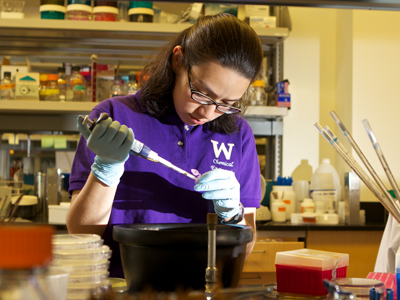
Mark Leddy, an NSF Program Officer, shared data collected as part of NSF’s Participant Data Management System (PDMS), regarding the engagement of STEM students and mentors with disabilities in NSF-funded Alliance projects. The PDMS data shows, in part, how RDE-funded Alliances, such as AccessSTEM have supported activities in more than one dozen states and served thousands of primary, secondary, community college, and university students with disabilities.
Alliances provide research and industry internships, mentoring, and other evidence-based interventions for students with disabilities as well as professional development for educators and employees. The Alliances have also acted as a catalyst and resource for institutions and employers in their efforts to recruit and retain individuals with disabilities in STEM. They have distributed replication models, curriculum materials, checklists, videos, and other products. They contribute to a shared searchable Knowledge Base to maximize their impact.
Mark remarked that the NSF has made strong statements about moving forward with broadening participation, and that funding is moving towards education research and away from Alliance projects. Mark noted that this represents a real change from where we were ten years ago.
Reports from Panel Discussions
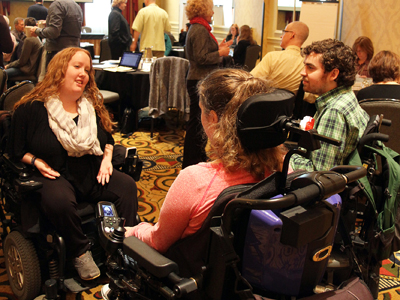
Panelists included current college students and recent graduates:
- Jeremy Caci, Western Washington University
- Erica Chavez, University of Washington
- Sean Marihugh, University of Washington
- Macy Westrick, University of Washington
In this highly-rated activity on the second day of the CBI, four STEM students with disabilities shared their stories and experiences in a panel presentation.
What was your biggest surprise when entering college?
Erica: I never thought I would be doing research and presenting about it. Because of programs aimed at increasing diversity in the field, I was exposed to experiences I wouldn’t have had otherwise.
Macy: In high school, teachers try to scare you and make you afraid of going to college. My biggest surprise was how much I loved college and how difficult high school was for me.
Jeremy: My biggest surprise about college was how much studying I had to do outside of class. I also enjoyed practicing self-directed learning and got to create my own curriculum during my last year of college.
Erica: My biggest surprise in college was how big my campus was! I grew up in a small town and I felt like my dorm was bigger than my town!
What advice would you give to your 8th grade self?
Macy: I had a one-on-one [personal care attendant] in high school, but in preparation for college I started being more independent. I wish I had done that sooner.
Jeremy: I wish I knew how to ask for help. I had an ego, so when I struggled I should have asked for help. I also wasn’t diagnosed until high school, so maybe it would have been sooner had I asked for help.
Erica: Love yourself and be optimistic.
When did you decide that college was your postsecondary option?
Erica: Very early on. I knew in high school.
Jeremy: When I realized that life is always going to be a challenge, so college is just another layer of that.
Macy: My parents always expected it of me, but I would have went anyways.
Is there anything you would have changed about your college experience?
Macy: I wish I wasn’t one of the only people in a wheelchairs on campus. I also wish that classrooms were flagged as being accessible.
Jeremy: I wish there had been more information about classes so I could make a more informed decision about what my classes would be.
Erica: Being more connected to resources and programs who have helped me beyond graduation.
How do you use technology in the classroom?
Macy: A large part of me becoming independent was technology I was given where I could control my computer with my voice. It truly changed my life.
Jeremy: I utilized the fact that my library at school offered books in PDF format, and it helped me greatly.
Reports from Working Groups
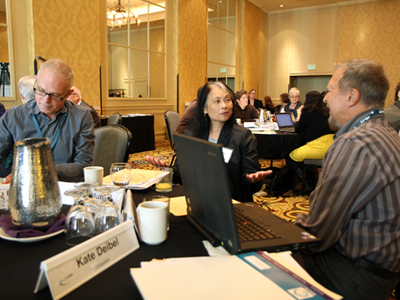
What are examples of interventions that can promote participation and success of students with sensory impairments studying STEM?
- Teach students to self-advocate. For K-12, students may have IEPs, parent assistance, and structure that is unavailable in college.
- Separate technically easy problems, like captioning, from difficult problems like database diagramming. The former requires organizational and behavioral interventions; the latter, new technical developments.
- Revisit assumptions about literacy.
- Consider human-computer interaction tools.
- Upgrade classroom supports. Move lectures to captioned video to make them more accessible for students who are sensory impaired. Use in-class discussion as a way to encourage engagement between students with disabilities and students without disabilities.
- Use STEM-trained interpreters.
- Caption lectures with headlines outlined in the transcript (making the structure similar to that of a textbook). Create scaffolds for captioned content.
- Pair students who use similar technologies for mentoring and tutoring.
- Create an accessible science equipment lending library.
What are specific academic coaching, mentoring, and other interventions that can be employed to support students with disabilities?
- Create mentorship opportunities in many forms including group, individual, and e-mentoring by peers, students, educators, and faculty.
- Consider mentors who may or may not have disabilities, but can still be strong advocates. Consider the benefits of matching by gender.
- Tell personal stories. Building a rapport with one student can lead to building community and culture.
- Find mentors based on specific criteria, for example, at FabFems.org.
- Engage in socio-emotional advising.
- Make efforts to increase student engagement with peers. Provide transportation assistance.
- Create a mentoring group using social media such as Facebook, Twitter, Instagram, and Pinterest.
- Connect with students using identitiy development models, career coaching based on the student strengths, and industry connections related to the student goals.
- Suggest a thought-provoking media series for students to review, such as a three to five episode series on YouTube.
- Consider ways to reach postsecondary students who do not self-disclose.
- Offer a summer bridge program.
How can postsecondary faculty and other stakeholders promote the STEM success of students with disabilities using universal design (UD) and other strategies?
- Establish a faculty council with a mission of inclusion.
- Consider the identity issues of veterans, their disincentives to participate, and how universal design can address their needs.
- Employ accessibility liasons to support faculty.
- Introduce UD as part of new faculty training. Include how to adapt instruction for specific disabilities. Create models for how to implement UD, including easy to understand examples.
- Include accessible designs in technology contracts as the contractor’s responsibility.
- Promote faculty, staff, and student learning communities to discuss IT applications for life beyond the classroom.
- Widely distribute ways to make the web more accessible, like those included in AccessComputing’s 30 Web Accessibility Tips.
- Encourage campus accessibility champions to spread the word. Get testimonials from both students with disabilities and those without, and make successful outcomes more visible to faculty.
How can K-12 educators and other stakeholders employ UD or other K-12 interventions to facilitate interest and success in STEM education for students with disabilities?
- Start outreach early, like NCWIT’s AspireIT Middle School Outreach Program.
- Design professional development days and courses using UD.
- Offer informal education experiences like after school programs and conversations with youth development professionals to avoid challenges that may arise in formal settings.
- Partner with organizations which have both resources and a common interest in increasing diversity, such as GMSP, NCWIT, or Georiga Tech.
- Open lines of communication between postsecondary disabled student services offices to high school special education directors and teachers.
- Try engaging through the virtual online community Second Life. The initial benefit may be for students with social or behavioral challenges, but it can be useful for everyone.
- Accommodate different learning styles and technology so students get a strong foundation in STEM, then expose them to fun science to see where their interests lie.
- Provide opportunities for parents to learn how to encourage STEM at home, including a learning community for parents.
- Teach all students about assistive technology and software. Create opportunities for students who use assistive technology to be teaching assistants in K-12 schools.
- Provide opportunities for K-12 educators to learn about UD, accommodations, and assistive technology for credit.
- Set a goal for every student to have a positive STEM experience in elementary school.
- Look at K-12 programs like Project Lead the Way and talk with the teachers involved.
- Use images in materials that reinforce an “I can” attitude and depict a diverse student population.
What kind of supports for K-12 to college, two-year to four-year, and military to civilian transitions might maximize the success of students with disabilities in STEM?
- Secure funding that supports the replication of successful practices, not just the development of a shiny new program.
- Offer programs which provide services and supports without requiring formal “enrollment” or labeling. For veterans, there are specific issues around disability terms that can be stigmatizing or misenterpreted.
- Offer mentorship programs for campus veterans like the Virginia Commonwealth University V.E.T.S. in College program.
- Provide professional development for K-12 high school counselors. Build stronger professional collaborations with high school counselor groups.
- Deliver training in self-advocacy skills, including time management, in multiple communication formats.
What technology/science equipment strategies have the potential to promote the success of students with disabilities?
- Promote a positive job outlook in STEM fields.
- Make accessible science equipment “standard” in all classrooms and labs, starting in K-12. Widely distribute resources about accessible science equipment and labs.
- As Everett Rodgers points out, people won’t accept innovation unless the innovation fills a need. In education settings, the “need” should be apparent to both the student and the instructor.
- Design low-tech options using everyday and common materials, thereby making accommodations less “special.”
- Teach web design, coding skills, and plug-in modules using UD.
CBI Participants
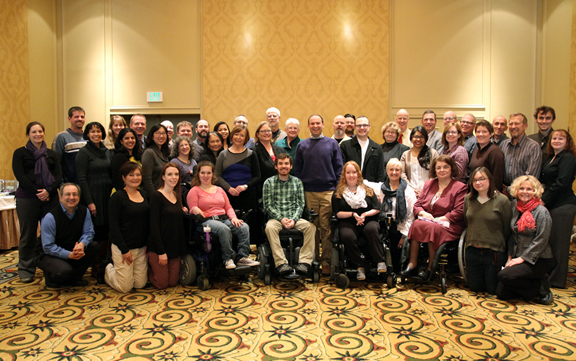
Stakeholder groups represented in the CBI included
- student services leaders and administrators,
- STEM faculty members,
- STEM students, and
- professional organizations.
The following individuals participated in the CBI.
Christopher Andersen
Director, STEM Initiatives
Ohio State University
Bob Austin
CTE Specialist
Science, Engineering & Industry, Art, Humanities, Communications and Agriculture
Seattle Public Schools
William Badders
President
National Science Teachers Association
Scott Bellman
Program Manager
DO-IT
University of Washington
Jeffrey Bigham
Associate Professor
Human-Computer Interaction Institute
Carnegie Mellon University
Jose Blackorby
Center Director
SRI International
Anna Box
Math Department Manager
Seattle Public Schools
Kayla Brown
Program Assistant
DO-IT
University of Washington
Sheryl Burgstahler
AccessSTEM PI and Director
Director, DO-IT and Accessible Technology Services
University of Washington
Bree Callahan
Director
Disability Resources
University of Washington
Dan Comden
Access Technology Center
University of Washington
Lyla Crawford
Program Coordinator
DO-IT
University of Washington
Mary Davison
Career and Technical Education Manager
Seattle Public Schools
Katherine Deibel
Consultant
Tony Delisle
Post Doctoral Associate
University of Florida
Lisa Elliot
Senior Research Scientist
National Technical Institute for the Deaf Center on Access Technology
Rochester Institute of Technology
John Gallagher
Professor
Department of Computer Science and Engineering
Wright State University
Sara Gardner
Program Manager
Autism Spectrum Navigators Program
Bellevue College
Nimisha Ghosh Roy
Program Manager
Edlab Group/National Girls Collaborative Project/Pacific Northwest
National Girls Collaborative Project
Lilna Givan Williams
Worksite Learning Coordinator
Seattle Public Schools
Susan Gjolmesli
Director
Disability Resource Center
Bellevue College
Jim Gorske
Director
Disability Resource Center
University of Florida
Doug Hayman
Program Coordinator
DO-IT
University of Washington
Susan Higgins
Career and College Specialist
Seattle Public Schools
Ronda Jenson
Director of Research
University of Missouri, Kansas City
Consuelo Kreider
Research Assistant Professor
Department of Occupational Therapy
University of Florida
Richard Ladner
AccessComputing PI
Professor
Computer Science and Engineering
University of Washington
Jonathan Lazar
Professor
Computer and Information Sciences
Towson University
Daniela Marghitu
Faculty Coordinator and Director
Research Lab for Education and Assistive Technology
Auburn University
Sean Marihugh
A Team
DO-IT
University of Washington
Yovhane Metcalfe
Assistant Professor
VCU Rehabilitation Research Training Center
Virginia Commonwealth University
Terry Morreale
Associate Director and CTO
National Center for Women & Information Technology
Myrna Muto
CTE Career Guidance Specialist
Seattle Public Schools
Jeff Olson
Transition Coordinator
Seattle Public Schools
Graca Ribeiro
Skill Center Instructor
Seattle Public Schools
Stephan Smith
Executive Director
Association on Higher Education and Disability
Al Souma
DSS Coordinator/Faculty
Disable Student Services
Seattle Central Community College
Andreas Stefik
Assistant Professor
Department of Computer Science
University of Nevada, Las Vegas
Bob Stodden
Director
Center on Disability Studies
University of Hawaii, Manoa
Terry Thompson
Technology Accessibility Specialist
DO-IT
University of Washington
Tami Tidwell
Program Coordinator
DO-IT
University of Washington
Shani Watkins
Skill Center Principal
Seattle Public Schools
Jennifer Yu
Senior Research Scientist
SRI International
Debra Zawada
Program Coordinator
DO-IT
University of Washington
Communities of Practice
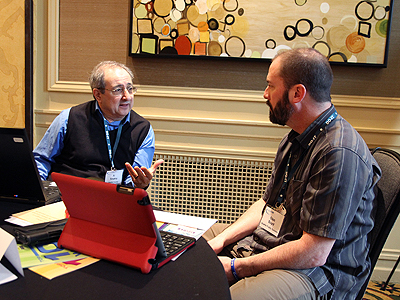
With supplement funding, DO-IT engages the stakeholders described before along with other national leaders within Communities of Practice (CoPs). CoPs share perspectives and expertise and identify practices that promote the participation of people with disabilities in STEM fields.
STEMed CoP
This CoP is populated with K-12 and postsecondary educators and administrators interested in promoting the success of students with disabilities in STEM courses and careers. Participants
- exchange ideas and suggestions for future collaboration and funding.
- gain and share knowledge and help identify issues related to the underrepresentation of people with disabilities in STEM fields.
- discuss promoting people with disabilities to professional STEM organizations so that members can help these organizations make their websites accessible, their conferences accessible
to attendees with disabilities, and their conference programs inclusive of disability-related topics. - help plan, attend, and/or recruit others to participate in the project/CoP.
- provide content for DO-IT’s searchable Knowledge Base.
- identify STEM events to which stakeholders and students might be invited.
- discuss how to include accessibility topics in STEM curricula.
- encourage targeting articles to STEM publications.
Broadening Participation CoP
Individuals who administer projects that serve to broaden participation in STEM fields
- discuss how to recruit participants with disabilities and accommodate them in their programs and activities and how to make their offerings more accessible overall.
- co-sponsor events and discuss potential new projects and share funding possibilities.
Disability Services CoP
Comprised of disability service professionals from community and K-12 schools, technical colleges, four-year colleges, and universities. Members of this CoP
- deliver presentations to faculty in order to share information about accommodations and campus services for students with disabilities.
- work with educators and administrators to invite students with disabilities to career fairs, lectures, and other events; work with groups to make sure activities are accessible; and help bring speakers with disabilities and exhibits that focus on disability-related topics.
- develop transition and bridge workshops and help other CoP members develop such activities.
Universal Design in Higher Education CoP
Those interested in exploring universal design (UD) and its applications in higher education discuss
- promising practices for infusing universal design on postsecondary campuses, and
- applying UD to all educational opportunities that include instruction, technology, student services and physical spaces.
Veterans CoP
Populated by veterans with disabilities, service providers, and volunteer mentors, members of this CoP
- discuss how to recruit veterans with disabilities and accommodate them in their programs and activities.
- share common concerns in their practices, and identify problems, goals, and concerns.
- develop internships, academies, and workshops to complement their program activities.
How to Join a CoP
You and your colleagues can join CoPs by sending the following information to doit@uw.edu:
- CoP you would like to join
- name
- position/title
- institution
- postal address
- email address
Websites and Knowledge Base
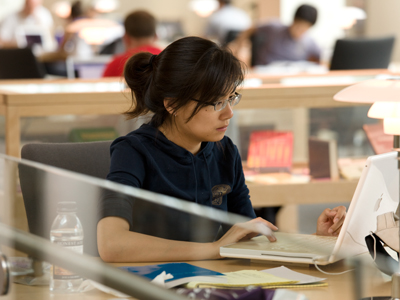
The AccessSTEM website contains
- information about project goals,
- the application of evidence-based practices toward project deliverables,
- resources for students with disabilities,
- educational materials for postsecondary faculty and staff,
- information about partners and collaborators, and
- program applications.
DO-IT maintains a searchable database of frequently asked questions, case studies, and promising practices related to how educators and employers can fully include students with disabilities in STEM activities.
The Knowledge Base can be accessed by following the “Search Knowledge Base” link on the AccessSTEM website.
The Knowledge Base is an excellent resource for ideas that can be implemented in programs in order to better serve students with disabilities. Individuals and organizations are encouraged to propose questions and answers, case studies, and promising practices. In particular, the promising practices articles serve to spread the word about practices that show evidence of improving the participation of people with disabilities in STEM fields. Contributions and suggestions can be sent to doit@uw.edu.
Examples of Knowledge Base questions include the following:
- What are key issues for increasing the successful participation of individuals with disabilities in STEM fields?
- How can I make my chemistry labs accessible to students with disabilities?
- Are there guidelines for describing STEM images within digital talking books?
- Are there screen readers that can read math equations?
- How can web design teachers learn to incorporate web accessibility in their courses?
- What are some low-tech assistive technologies that aid computer access?
- What adaptive technology is typically provided to students with disabilities on postsecondary campuses?
- What are strategies for recruiting students with disabilities to STEM fields?
- Is there a way to add captions to a video that is already published?
- Are there any web-based tutorials on accessibility?
- How can universal design be applied in educational settings?
The RDE Collaborative Disseminations website contain materials designed to increase awareness of how people with disabilities can be successful in science, technology, engineering, and mathematics (STEM) as well as how other programs can make their web and print resources, courses, and activities more welcoming and accessible to people with disabilities. They can be used for individual and group instruction. The ultimate goal of RDE Collaborative Dissemination Project efforts is to broaden the participation in STEM fields and improve these fields with the talents and perspectives of individuals with disabilities.
Upcoming Resources
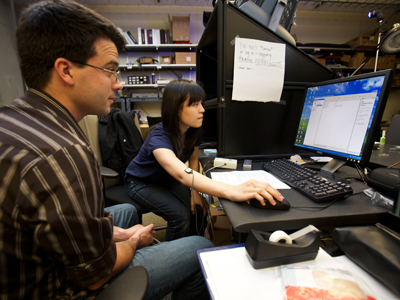
CBI participants provided input for future AccessSTEM resources currently in development. These resources are designed to support the AccessSTEM goal and will also benefit from significant input from student leaders, staff members, and partners.
Online Publications
Two project publications will be freely available online. The first publication will encourage postsecondary institutions, through direct service and outreach, to make STEM programs and support services welcoming and accessible to students with disabilities. Approximately 100 pages in length, the publication will include:
- Specific, practical suggestions for making STEM labs, classrooms, online resources, and curricula welcoming and accessible to everyone.
- Examples of easy fixes (e.g., including in the accessible design of a science lab, adjustable-height workstations and assistive technology) as well as more long-term approaches (e.g., changing the culture of a STEM department or college to be more inclusive of individuals with disabilities).
- Evidence-based practices, developed and evaluated by past and current RDE-funded projects.
The second publication will share pictures and bios of approximately fifty successful students and employees with disabilities in STEM. Most will be participants and mentors in the AccessSTEM project, but other projects will be asked to solicit contributors as well. This product will make it clear that people with disabilities can be and are successful in STEM fields while also highlighting some of the challenges they face.
Video
Targeted at postsecondary institutions, the video will share strategies for making departments, programs, and resources, particularly those in STEM, welcoming and accessible to students with disabilities. It will complement the first publication described above. Filming was conducted during the CBI.
Website
A new website, The Science Lab, will be developed as an addition to DO-IT’s popular AccessCollege collection of stakeholder-focused websites. Other websites in the collection are:
- The Faculty Room — For faculty and academic administrators.
- The Student Services Conference Room — For staff and administrators.
- The Employment Office — For employers and career services.
- The Student Lounge — For students with disabilities.
- The Veterans Center — For veterans with disabilities and those who work with them.
- The Board Room — For high-level administrators.
- The Center for Universal Design in Education — Principles, processes, guidelines, checklists, and promising practices for applying universal design to instruction, student services, technology, and physical spaces.
Acknowledgments
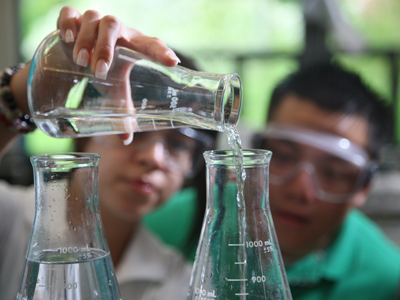
AccessSTEM Capacity Building activities are funded by the National Science Foundation (Award #HRD-0833504). They were coordinated by the Alliance for Students with Disabilities in Science, Technology, Engineering, and Math (AccessSTEM) at the University of Washington. Any opinions, findings, and conclusions or recommendations expressed in this material are those of the CBI presenters and publication authors and do not necessarily reflect the views of the National Science Foundation.
DO-IT
University of Washington
Box 354842
Seattle, WA 98195-4842
doit@uw.edu
www.washington.edu/doit
206-685-DOIT (3648) (voice/TTY)
888-972-DOIT (3648) (toll free voice/TTY)
206-221-4171 (FAX)
509-328-9331 (voice/TTY) Spokane
Founder and Director: Sheryl Burgstahler, Ph.D.
Program Manager: Scott Bellman
© 2014 University of Washington. Permission is granted to copy this publication for educational, noncommercial purposes, provided the source is acknowledged.